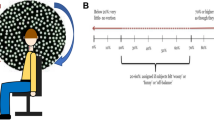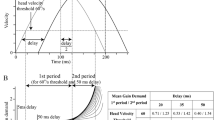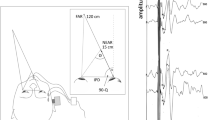Abstract
Vestibulo-ocular reflex (VOR) transfer characteristics are well documented in various species for frequencies up to 1 Hz. Natural active and passive head movements, however, have frequency components well above 1 Hz (Donaghy 1980)and accelerations exceeding several thousand deg/sec2. Stimulation in this range requires special apparatus which have become available only recently at reasonable costs and therefore only few published data exist. In this frequency range the peripheral vestibular organ is probably the exclusive sensory organ which contributes to compensatory eye movements; data on a possible contribution of neck afferents (cervico-ocular reflex COR), however, are still controversial.
Access this chapter
Tax calculation will be finalised at checkout
Purchases are for personal use only
Preview
Unable to display preview. Download preview PDF.
Similar content being viewed by others
References
Donaghy M (1980) The cat’s vestibulo-ocular reflex, J.Physiol (London) 300, 337–351.
Fernandez C and Goldberg JM (1976) Physiology of peripheral neurons innervating otolith organs of the Squirrel monkey, response dynamics, J. Neurophysiol 39, 996–1008.
Furman JM et al (1982) Dynamic range of the frequency response of the horizontal vestibulo-ocular reflex of the alert Rhesus monkey, Acta otolaryngol 93, 81–91.
Goldberg JM and Fernandez C (1975) Responses of peripheral vestibular neurons to angular and linear acceleration in the Squirrel monkey, Acta otolaryngol 80, 101–110.
Miles FA and Eighmy BB (1980) Long term adaptive changes in the primate vestibulo-ocular reflex, J.Neurophysiol 43, 1406–1425.
Keller EL (1978) Gain of the vestibulo-ocular reflex in the monkey at high rotational frequencies, Vision Res 18, 311–315.
Author information
Authors and Affiliations
Editor information
Editors and Affiliations
Rights and permissions
Copyright information
© 1982 Dr W. Junk Publishers, The Hague, Boston, London
About this paper
Cite this paper
Böhmer, A., Henn, V., Suzuki, JI. (1982). Compensatory Eye Movements in the Monkey During High Frequency Sinusoidal Rotations. In: Roucoux, A., Crommelinck, M. (eds) Physiological and Pathological Aspects of Eye Movements. Documenta Ophthalmologica Proceedings Series, vol 34. Springer, Dordrecht. https://doi.org/10.1007/978-94-009-8000-6_15
Download citation
DOI: https://doi.org/10.1007/978-94-009-8000-6_15
Publisher Name: Springer, Dordrecht
Print ISBN: 978-94-009-8002-0
Online ISBN: 978-94-009-8000-6
eBook Packages: Springer Book Archive




